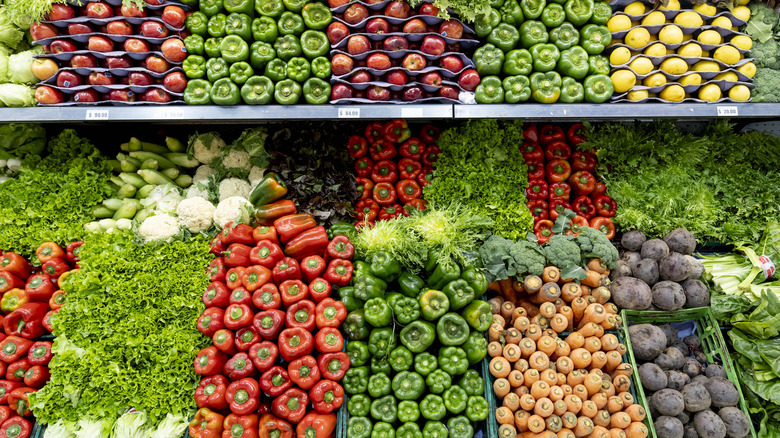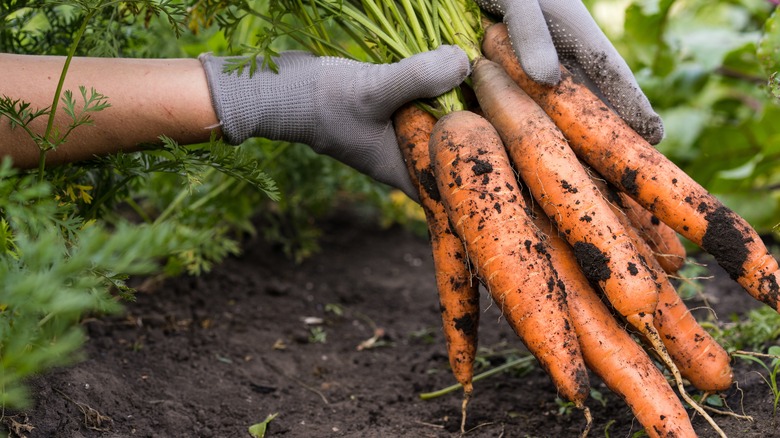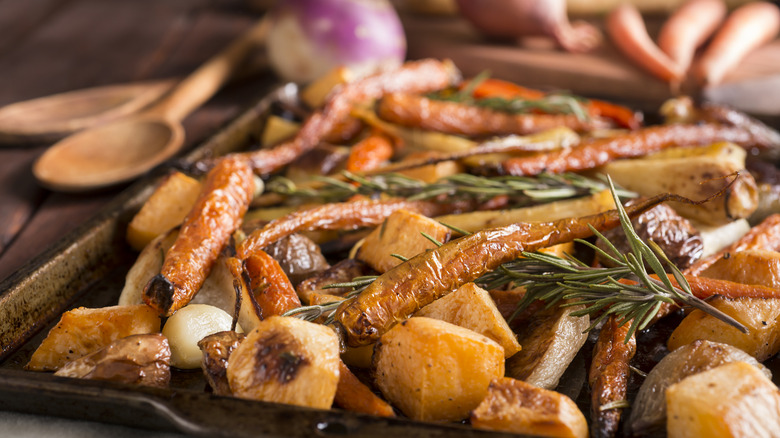Why Extra Large Vegetables Are A Red Flag At The Grocery Store
As you stand in front of the colorful shelves of vegetables piled high at your local grocery store, trying to decide what to buy for dinner, you may notice that the beets you bought last week are now twice as big, and some of the sweet potatoes are huge, while others are much more tiny. While it is natural for vegetables to come in a range of shapes and sizes, when it comes to flavor and nutrition, bigger isn't always better.
If the price of a certain veggie is per item, rather than per pound, buying the biggest squash or bell pepper you can find seems like a bang for your buck — but in reality, the opposite is true. Extra-large vegetables may have been pumped up with an excess of water, resulting in a bland flavor and unpleasant texture that may be watery or fibrous. Smaller vegetables, on the other hand, offer a higher concentration of flavor compounds and nutrients in every bite, which will help you create a more delicious and nutritious meal.
The flavorful benefits of smaller produce
You might figure that bigger and smaller veggie of the same variety don't have much of a difference. However, it's worth it to skip out on hulked-out produce and pick through the pile to find smaller gems, whether they be carrots, zucchinis, or even fruits like melons. To understand this rationale, it can be helpful to learn about how produce is grown.
Crop size is determined by a number of factors resulting from the plant's natural environment and the farmer's work, including temperature, light, and water. A vegetable needs a certain amount of sunlight and warmth to stimulate growth, but the final factor, water, is especially important for determining its flavor and nutritional quality. If a farmer irrigates a field with too much water, it will bulk up the size of their vegetables, but this bulk is made of just that: water, which has no flavor or nutritional value, and only dilutes those qualities in a vegetable.
Water isn't all bad, though, and so long as the veggies are small, you should actually look for ones that don't seem to have lost any water content. Besides judging your produce based on appearance, assess its weight and texture. Good vegetables tend to be heavy and firm, which are indicators that they were recently harvested, as their cell structure is still intact and they have not become dehydrated over time. Smaller vegetables that feel heavier than you'd think are the best choice.
When oversized vegetables are the only option
If enormous or otherwise less-than-ideal vegetables are the only option at your grocery store, you can still make a great meal out of them. You just have to be clever in terms of preparation and flavorings. Keep in mind that vegetables grown with an excess of water can be watery and tough inside, so rather than serving them raw in a salad or on a platter with dipping sauces, take some extra time to cook and properly season them.
One easy way to do so is to roast your vegetables to perfection. Simply wash and chop your vegetables, spread them evenly on a baking tray, cover with extra virgin olive oil and a sprinkle of salt, then pop them in the oven. Some time and heat will help to intensify and sweeten the flavors in the vegetables, while creating pleasantly crispy edges and a soft interior. Any sort of flavor-based or textural inconsistencies will be virtually blotted out.
Another simple solution to improve the taste and texture of large vegetables is to throw them into a restorative soup. When boiled to a uniform softness or — even better — pureed to be completely smooth, no one will be able to tell that you started out with a watery, oversized load of turnips or eggplants.



